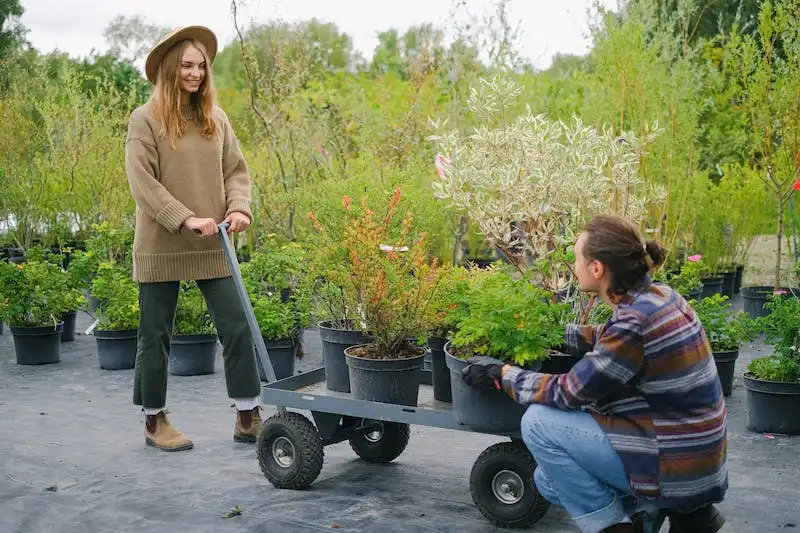Gardeners have long realized the benefits of mixing certain plants together in their gardens. One such pairing that has gained popularity is growing marigolds with tomatoes. Marigolds, with their vibrant colors and distinct scent, are not only beautiful but also serve many purposes in a vegetable garden.
One of the main reasons gardeners choose to grow marigolds with tomatoes is because marigolds are known to attract pollinators. Bees and other beneficial insects are attracted to the bright colors and sweet scent of marigolds, which helps to maximize the pollination process for both the marigolds and the tomatoes.
In addition to attracting pollinators, marigolds also act as natural pest repellents. Marigolds release a chemical called thiophene, which is known to deter pests such as whiteflies, aphids, and mites. By planting marigolds alongside tomatoes, gardeners can help protect their tomato crops from these common pests and diseases.
Another benefit of growing marigolds with tomatoes is that marigolds can improve the overall health of the soil. Marigold roots release a substance that helps to suppress nematodes, a type of microscopic roundworm that can damage tomato roots. By planting marigolds in the same area as tomatoes, gardeners can help prevent nematode infestation and promote healthier tomato plants.
Furthermore, marigolds can also help to deter certain types of weeds from taking over the garden. Their dense foliage and strong scent make it difficult for weeds to establish themselves around the tomato plants. This means less time spent weeding and more time enjoying the fruits (or vegetables) of your labor.
Overall, growing marigolds with tomatoes is a fun and beneficial gardening practice. Whether you’re a seasoned gardener or just starting out, incorporating marigolds into your vegetable garden can help support the growth and health of your tomato plants. So next time you’re planning your garden layout, consider adding some marigolds alongside your tomatoes.
Remember, there are many different varieties of marigolds to choose from, such as Tagetes patula (French marigold) or Tagetes erecta (African marigold). Experiment with different types and see which ones thrive best with your tomatoes. Happy gardening!
Marigold And Tomato Companion Planting: Do Marigolds And Tomatoes Grow Well Together
Companion planting is a gardening technique where different plants are grown together to maximize their benefits for each other. One frequently practiced companion planting combination is marigolds and tomatoes. Marigolds (Tagetes spp.) are known to attract a wide range of beneficial insects, while tomatoes (Solanum lycopersicum) often struggle with pests. By planting marigolds and tomatoes together, gardeners can take advantage of the benefits these plants offer each other.
Marigolds are often considered the best companions for tomatoes because they offer a variety of benefits. First, marigolds attract hoverflies, ladybugs, and other beneficial insects that feed on aphids, mites, and other pests that commonly affect tomatoes. This can help keep pest populations under control, reducing the need for chemical intervention. Additionally, marigolds have a strong and distinctive scent that can deter harmful insects like whiteflies and nematodes.
When planting marigolds and tomatoes together, it is important to choose the right marigold varieties. Dwarf marigolds, such as the French or signet marigold varieties, are the best choice as they will not overshadow the tomato plants. Additionally, smaller marigold varieties have a more concentrated scent, which is ideal for attracting beneficial insects.
There are a few different ways to incorporate marigolds into your tomato planting. One option is to plant marigolds in a border or around the perimeter of the tomato bed. This creates a barrier that pests may be less likely to cross. Another option is to interplant marigolds and tomatoes, alternating them in rows or groups. This can help maximize the benefits of companion planting, as the marigolds will be closer to the tomatoes.
It is worth noting that while marigolds can benefit tomato plants, the reverse is not necessarily true. Tomatoes do not offer as many benefits to marigolds, which is why marigolds are often the preferred companion plant. However, tomatoes can still provide some benefits to marigolds by attracting bees and other pollinators that can help with marigold seed production.
Marigolds and tomatoes can also be grown together in container gardening or greenhouse setups. In these environments, marigolds can help deter pests and attract beneficial insects, while tomatoes provide shade and support for the marigolds to climb on.
One frequently asked question about marigolds is whether they actually trap pests. While marigolds are often credited with trapping and killing nematodes, recent research suggests that their pest-trapping qualities may be somewhat exaggerated. However, marigolds can still provide the benefits mentioned above, so they are worth planting alongside tomatoes even if their pest-trapping abilities are not as significant as once believed.
In addition to marigolds, there are other companion plants that can benefit tomatoes, such as basil, beans, borage, carrots, celery, and nasturtiums. Experimenting with different combinations of companion plants can help create a diverse and thriving garden.
In conclusion, marigolds and tomatoes can grow well together, making them a popular companion planting combination. Marigolds attract beneficial insects, deter harmful pests, and provide some shade and support for tomatoes. By incorporating marigolds into your tomato planting, you can enhance the health and productivity of both plants.
Planting Marigolds with Tomatoes
When it comes to companion planting, there are many combinations that can benefit your crops in different ways. One of the most popular and well-known combinations is planting marigolds with tomatoes.
Marigolds, scientifically known as Tagetes, have been a favorite companion plant for tomatoes for a long time. They not only add beauty to your garden with their vibrant flowers, but they also offer several benefits to your tomato plants.
One of the key benefits of planting marigolds with tomatoes is their ability to attract pollinators. The scent of marigolds is especially attractive to bees and other beneficial insects, which can help increase the pollination of your tomato plants and ultimately lead to better yields.
Marigolds are also known for their ability to repel certain pests. Their strong scent is disliked by aphids and other insects that can damage your tomato plants. By planting marigolds alongside your tomatoes, you can help deter these pests and protect your crop.
Another benefit of having marigolds in your tomato garden is that they can help improve the soil. Marigold roots release chemicals that suppress nematodes, which are microscopic worms that can harm the roots of your tomato plants. This can lead to healthier tomato plants and better overall growth.
When it comes to companion planting, there are a few other plants that go well with tomatoes. Basil (Ocimum) and chives (Allium schoenoprasum) are two examples of companion plants that can be grown alongside tomatoes. They both have a strong scent that can help deter pests, and they can also attract beneficial insects. Borage (Borago officinalis) is another popular companion plant that attracts bees and other pollinators.
It’s important to note that not all companion plants should be planted alongside tomatoes. Some plants, such as fennel and potatoes, can actually inhibit the growth of tomatoes and should be avoided as companions.
If you’re looking for a fun and practical addition to your garden, consider planting marigolds with your tomatoes. They offer a variety of benefits and can help maximize the potential of your tomato crop. Whether you’re growing tomatoes in a greenhouse or in an outdoor garden, marigolds are a great companion plant to consider.
So, why not give it a try and see for yourself the difference it can make? Planting marigolds with tomatoes is a simple and effective way to promote healthy growth and protect your plants from pests and diseases.
If you have any questions about companion planting or if you’re unsure about which plants to choose, there are plenty of resources available online and in gardening blogs that can provide more information. And remember, gardening is all about experimenting and finding what works best for your specific needs and preferences.
Growing Tomatoes and Marigolds Together
Planting marigolds alongside tomato plants is a well-known gardening practice. These two plants are great companions for various reasons.
- Marigolds attract beneficial insects, such as pollinators and predators of common tomato pests like aphids and whiteflies. Their bright yellow, orange, and red flowers can act as an irresistible beacon, drawing these helpful insects to the garden.
- Marigolds release a pungent scent that repels mosquitoes and other pests. Their strong aroma acts as a natural deterrent, creating a barrier between your tomato plants and unwanted visitors.
- Apart from attracting beneficial insects and repelling pests, marigolds also have beneficial effects on tomato growth. The plants are known to improve tomato plant growth by providing shade to the soil, reducing evaporation, and conserving moisture for the tomatoes.
- When planted beside tomatoes, marigolds can help mask the scent of the tomato plant itself. This can confuse pests who rely on smell to locate their preferred host plants, making it more difficult for them to find your precious tomatoes.
- In addition to their compatibility with tomatoes, marigolds also make great companions for other vegetables. They can attract pollinators and deter pests from a variety of crops, such as peppers, lettuce, zucchini, potatoes, kale, and more.
- Marigolds are also a visually appealing addition to your vegetable garden. Their vibrant flowers bring color and beauty to your growing space, making it more enjoyable for you and your family to spend time tending to your plants.
- Planting marigolds in between tomato plants is a simple and fun way to enhance the overall health and productivity of your vegetable garden. Their low-maintenance nature makes them an ideal companion for tomatoes or any other vegetable you prefer to plant.
In conclusion, growing tomatoes and marigolds together can provide numerous benefits for your garden. From attracting pollinators and deterring pests to improving tomato plant growth and adding visual appeal, these two plants are a winning combination. Consider giving marigolds a try in your garden and witness the positive impact they can have on your tomato plants and the overall success of your vegetable garden.




